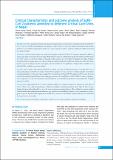Please use this identifier to cite or link to this item:
https://hdl.handle.net/20.500.14356/1004| Title: | Clinical Characteristics and outcome analysis of SARS-CoV-2 patients admitted to different Critical Care Units in Nepal |
| Authors: | Hamal, Pawan Kumar Poudel, Puspa Raj Yadav, Rupesh Kumar Sigdel, Rohini Chapagai, Badri Bhattarai, Ramesh Bhandari, Tirtha Raj Jha, Prabin Kumar Yadav, Sanjay Neupane, Anil Prasad Ghimire, Sailaja Poudel, Kiran Dhungana, Siddhartha Pokharel, Nabin Dhakal, Gaurav Raj Gyanwali, Pradip |
| Citation: | HamalP. K., PoudelP. R., YadavR. K., SigdelR., ChapagaiB., BhattaraiR., BhandariT. R., JhaP. K., YadavS., NeupaneA. P., GhimireS., PoudelK., DhunganaS., PokharelN., DhakalG. R., & GyanwaliP. (2022). Clinical Characteristics and outcome analysis of SARS-CoV-2 patients admitted to different Critical Care Units in Nepal. Journal of Nepal Health Research Council, 20(01), 47-53. https://doi.org/10.33314/jnhrc.v20i01.4167 |
| Issue Date: | 2022 |
| Publisher: | Nepal Health Research Council |
| Article Type: | Original Article |
| Keywords: | Corona virus disease critical care outcome severe acute respiratory syndrome mortality |
| Series/Report no.: | Jan-March, 2022;4167 |
| Abstract: | Abstract Background: The clinical presentation, biochemical characteristics, and outcomes of patients infected with SARS-CoV-2 can vary in different populations. The purpose of the study is to assess the clinical presentation and identify predictors of mortality among patients with severe acute respiratory distress syndrome admitted to different critical care units in Nepal. Methods: An observational study was conducted among the confirmed SARS-CoV-2 patients admitted to different critical care units in seven provinces of Nepal. Retrospective data was collected for the period of three months (April 14, 2021 to July 15, 2021) in relation to the peak of the second wave of COVID-19 pandemic in Nepal. Clinical, biochemical and mortality data were collected from the admitted patients of different critical care units. Univariate logistic regression analysis was done among the selected variables at 5% significance. Final predictor variables were identified after multiple regression analysis. Results: Out of total of 646 patients admitted to critical care units of different provinces of Nepal, there was a male predominance 420 (65%). A total of 232(35.91 %) patients were non-survivors with the majority of mortality occurring in patients > 50 years of age. Cough (72.3 %), shortness of breath (70.9%) and fever (56 %) were the most common presenting clinical features. Increasing age, presence of comorbidity, critical COVID-19 cases, respiratory rate, temperature, serum urea and alanine aminotransferase were identified as predictors of mortality after multiple regression analysis. Conclusions: Approximately 36 % of the confirmed SARS-CoV-2 patient admitted to critical care units did not survive. There was a male preponderance with most casualties occurring in patients more than 50 years of age. Cough, shortness of breath and fever were the most common presenting features. After multiple regression analysis of the identified clinical and biochemical factors, age, presence of comorbidity, respiratory rate, temperature, severity grade as per the World Health Organization classification, serum urea and alanine aminotransferase were identified as the predictors of mortality. Keywords: Corona virus disease; critical care; outcome; severe acute respiratory syndrome; mortality. |
| Description: | Original Article |
| URI: | http://103.69.126.140:8080/handle/20.500.14356/1004 |
| ISSN: | Print ISSN: 1727-5482; Online ISSN: 1999-6217 |
| Appears in Collections: | Vol. 20 No. 01 (2022): Issue 54 Jan-March, 2022 |
Files in This Item:
| File | Description | Size | Format | |
|---|---|---|---|---|
| 4167-Manuscript-27866-1-10-20220606.pdf | Fulltext Download | 225.26 kB | Adobe PDF |  View/Open |
Items in DSpace are protected by copyright, with all rights reserved, unless otherwise indicated.
